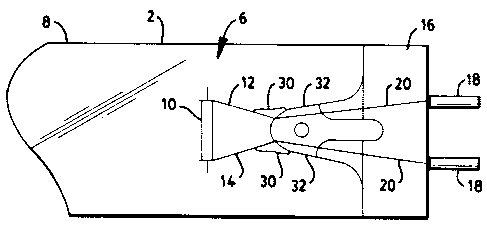Some of the information on this Web page has been provided by external sources. The Government of Canada is not responsible for the accuracy, reliability or currency of the information supplied by external sources. Users wishing to rely upon this information should consult directly with the source of the information. Content provided by external sources is not subject to official languages, privacy and accessibility requirements.
Any discrepancies in the text and image of the Claims and Abstract are due to differing posting times. Text of the Claims and Abstract are posted:
| (12) Patent: | (11) CA 2169581 |
|---|---|
| (54) English Title: | FLUORESCENT LAMP WITH END OF LIFE ARC QUENCHING STRUCTURE |
| (54) French Title: | LAMPE FLUORESCENTE AVEC STRUCTURE D'EXTINCTION D'ARC EN FIN DE DUREE DE VIE |
| Status: | Expired and beyond the Period of Reversal |
| (51) International Patent Classification (IPC): |
|
|---|---|
| (72) Inventors : |
|
| (73) Owners : |
|
| (71) Applicants : |
|
| (74) Agent: | R. WILLIAM WRAY & ASSOCIATES |
| (74) Associate agent: | |
| (45) Issued: | 2006-11-14 |
| (22) Filed Date: | 1996-02-15 |
| (41) Open to Public Inspection: | 1996-08-18 |
| Examination requested: | 2003-02-12 |
| Availability of licence: | N/A |
| Dedicated to the Public: | N/A |
| (25) Language of filing: | English |
| Patent Cooperation Treaty (PCT): | No |
|---|
| (30) Application Priority Data: | ||||||
|---|---|---|---|---|---|---|
|
A fluorescent lamp comprises a glass tube, an electrode at each end of the tube, a pair of lead wires extending through each sealed end of the tube and joined to one of the electrodes, and a deposit of metal hydride-containing paste disposed in the tube and having a decomposition temperature higher than temperatures within the tube during normal operation of the lamp.
Lampe fluorescente comprenant un tube de verre, une électrode à chaque extrémité du tube, une paire de fils traversant chacune des extrémités du tube fermées hermétiquement et sont reliés à une des électrodes, et une capsule qui contient une pâte d'hydrure métallique disposée dans le tube et dont la température de décomposition est plus élevée que les températures dans le tube lors du fonctionnement normal de la lampe.
Note: Claims are shown in the official language in which they were submitted.
Note: Descriptions are shown in the official language in which they were submitted.

2024-08-01:As part of the Next Generation Patents (NGP) transition, the Canadian Patents Database (CPD) now contains a more detailed Event History, which replicates the Event Log of our new back-office solution.
Please note that "Inactive:" events refers to events no longer in use in our new back-office solution.
For a clearer understanding of the status of the application/patent presented on this page, the site Disclaimer , as well as the definitions for Patent , Event History , Maintenance Fee and Payment History should be consulted.
| Description | Date |
|---|---|
| Time Limit for Reversal Expired | 2013-02-15 |
| Letter Sent | 2012-02-15 |
| Letter Sent | 2011-05-19 |
| Inactive: Adhoc Request Documented | 2010-05-20 |
| Inactive: Office letter | 2010-05-18 |
| Appointment of Agent Request | 2010-03-09 |
| Revocation of Agent Request | 2010-03-09 |
| Grant by Issuance | 2006-11-14 |
| Inactive: Cover page published | 2006-11-13 |
| Pre-grant | 2006-08-30 |
| Inactive: Final fee received | 2006-08-30 |
| Inactive: IPC from MCD | 2006-03-12 |
| Inactive: IPC from MCD | 2006-03-12 |
| Inactive: IPC from MCD | 2006-03-12 |
| Inactive: IPC from MCD | 2006-03-12 |
| Letter Sent | 2006-03-06 |
| Notice of Allowance is Issued | 2006-03-06 |
| Notice of Allowance is Issued | 2006-03-06 |
| Inactive: IPC assigned | 2006-03-06 |
| Inactive: Approved for allowance (AFA) | 2006-02-24 |
| Amendment Received - Voluntary Amendment | 2005-08-09 |
| Inactive: S.30(2) Rules - Examiner requisition | 2005-02-09 |
| Inactive: S.29 Rules - Examiner requisition | 2005-02-09 |
| Inactive: Application prosecuted on TS as of Log entry date | 2003-03-28 |
| Letter Sent | 2003-03-28 |
| Inactive: Status info is complete as of Log entry date | 2003-03-28 |
| All Requirements for Examination Determined Compliant | 2003-02-12 |
| Request for Examination Requirements Determined Compliant | 2003-02-12 |
| Application Published (Open to Public Inspection) | 1996-08-18 |
There is no abandonment history.
The last payment was received on 2006-02-13
Note : If the full payment has not been received on or before the date indicated, a further fee may be required which may be one of the following
Patent fees are adjusted on the 1st of January every year. The amounts above are the current amounts if received by December 31 of the current year.
Please refer to the CIPO
Patent Fees
web page to see all current fee amounts.
Note: Records showing the ownership history in alphabetical order.
| Current Owners on Record |
|---|
| OSRAM SYLVANIA INC. |
| Past Owners on Record |
|---|
| JOHN W. SHAFFER |